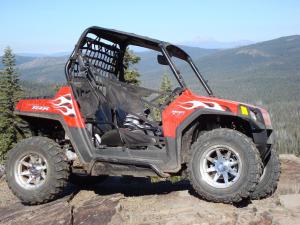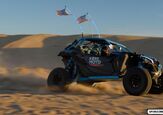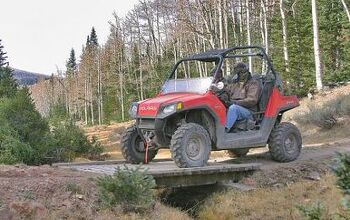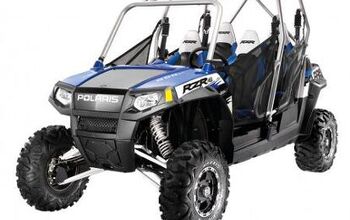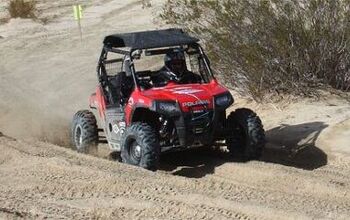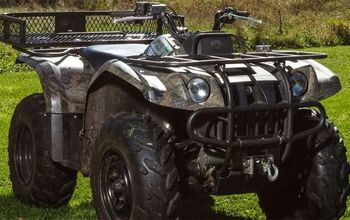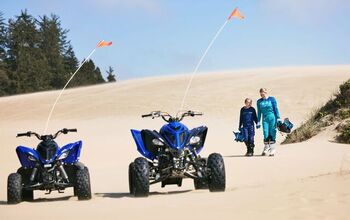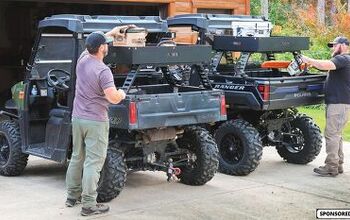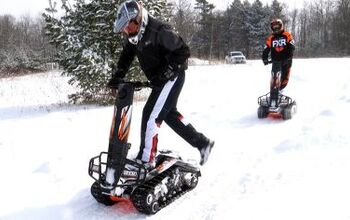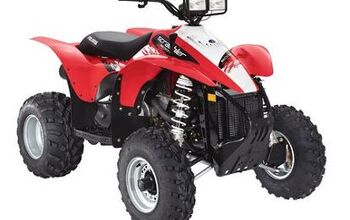2008 Polaris Ranger RZR Review
Polaris broke new ground with its sporty 2008 Ranger RZR, so ATV.com made some calls and set up a test ride.
We put the RZR through its paces up in the hills of northern California. We found a great mix of terrain, including fairly smooth, rolling fire trails and technical hills with huge rocks and fallen trees to maneuver through.
The RZR is much different than anything Polaris has ever released and is really a new animal entirely in the side-by-side market.
To start with, the RZR has a completely different look than its big brother, the Ranger XP. The Ranger XP is bigger, sits a lot higher and generally looks like a utility vehicle, while the RZR is more compact, has a much lower seating position and just looks like it was born to go fast.
Fortunately for us, those looks were not deceiving and the fire trails were the perfect spot to open up the throttle and see what the RZR was capable of.
Out of curiosity, we lined up the RZR beside the Ranger XP to test out acceleration. This is hardly a fair comparison since the Ranger XP was never intended to keep up with a sports-oriented vehicle, but we thought ‘to hell with fairness, let’s do it anyway.’
As expected, the RZR jumped out much faster and never looked back. The throttle response was very quick and the vehicle got up to speed in a big hurry. Top speed turned out to be about 55 mph, which is a lot more than the other vehicles it its class. The main competition for the RZR is the Yamaha Rhino and the Polaris’ big speed advantage was certainly no accident.
“We specifically wanted to build a unit that outperformed the Yamaha Rhino,” Polaris district sales manager Mike Carr told ATV.com. “Yamaha has done a fantastic job with the Rhino. We wanted to build a play first, work second vehicle that completely blew the market away and capture the attention of the Rhino enthusiast. And for the person that has a Rhino or was thinking about a Rhino, we wanted to give them something else to consider.”
The RZR is powered by a 760cc, 4-stroke, fuel-injected engine, which is basically the same motor that gives Polaris’ Sportsman 800 its ample brawn.
Polaris wanted the RZR to do a lot more than just go fast in a straight line. To keep the vehicle stable at high speeds, the engineers decided to place the engine behind the seat, rather than the seat on top of the engine. The result is a lower center of gravity and you can really feel the difference.
Because of the seat placement, the vehicle is a lot less likely to tip over. That gives you improved handling and the ability to go a lot faster around the corners without worrying as much about rolling.
That’s not to say the RZR couldn’t be tipped over. Like any other off-road vehicle, if you drive like you know you shouldn’t, bad things can happen. It’s just that with the RZR, you can be a little more aggressive.
Beyond flat, easy to navigate surfaces, the RZR continues to shine on more difficult terrain. Polaris continued its tradition and added independent rear suspension to its new side-by-side. This gives the vehicle 10 inches of ground clearance, which is only slightly less than the Ranger XP.
The RZR had little trouble keeping up with the Ranger XP on even the most rugged terrain. Generally, we took slightly less aggressive lines with the RZR than with the Ranger XP. That said, if there was no way around a rough patch of trail, you simply flipped the switch to four-wheel drive and worked your way over whatever was needed.
The RZR doesn’t necessarily look like it can handle the big rocks, but it’s built tough enough to handle as many bumps as you throw at it.
Over the course of a six-hour ride, the only time the RZR got into any trouble was when it got hung up on a huge fallen tree. Fortunately, all it took was the passenger getting out and standing on the bumper to help it across. Hardly a daunting task and nothing you wouldn’t expect to have to do from time to time in any such vehicle.
Comfort-wise, the RZR has taken a big leap over the Ranger XP. Instead of a bench seat, the RZR has a pair of individual, adjustable seats—both with three-point seatbelts. The driver also has tilt steering, which came in handy since there were significant height differences between drivers.
As for the passenger, Polaris included a grab bar that is placed about where a steering wheel would go. This was a surprisingly nice feature as it gave you a little more stability over the rougher terrain. We lovingly referred to it as the ‘Oh s–t!’ bar, as it was often used when the driver decided to see how far he could push the boundaries and the passenger’s only recourse was to hang on tight and shout obscenities.
Though the RZR was built with sport in mind, it does come with a bed in the back that has a payload capacity of 300 pounds and a towing capacity of 1,500 pounds.
The RZR also comes with Polaris’ lock and ride cargo system. Our vehicle had a covered box in the back, which was locked in with the very easy-to-use plunger system. No tools are required to add or change the accessories. That came in handy as we kept our lunch in the covered box and had a minor mayonnaise spill. Carr, who had to clean up our mess, simply had to unlock the four plungers, lift the box out and rinse it out. (Yes, ATV.com did feel a little bad about making him clean up the mess, but that feeling quickly passed.)
With an MSRP of US$10,299, the Ranger RZR is $200 less than the more utilitarian Ranger XP and the base Yamaha Rhino 700 FI Auto.
The bottom line is the RZR is fast, fun, unique and it looks cool. If you are looking for a working vehicle, this probably isn’t for you. But if you want something with a lot more sport and attitude, this Ranger is definitely worth checking out.
Related reading:
I have been working exclusively in digital media since 1997. I started out with TSN.ca, spending nearly nine years creating and editing content on Canada's leading sports website. I left to join VerticalScope, Inc., one of the world's largest online publishers, to start a number of powersports publications. While at VerticalScope, I've helped create and oversee content for a wide variety of different publications, including ATV.com, Off-Road.com, ArcheryTalk.com, Tractor.com, RVGuide.com, and many more.
More by Lucas Cooney



